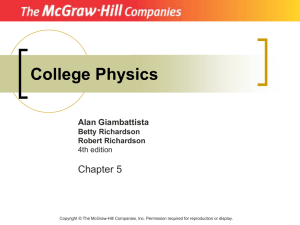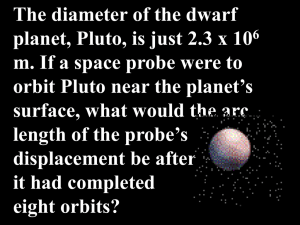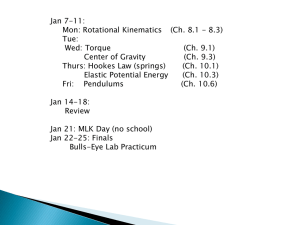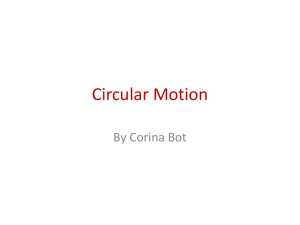rotational dynamics 1- moments of inertia and equation of motion
advertisement
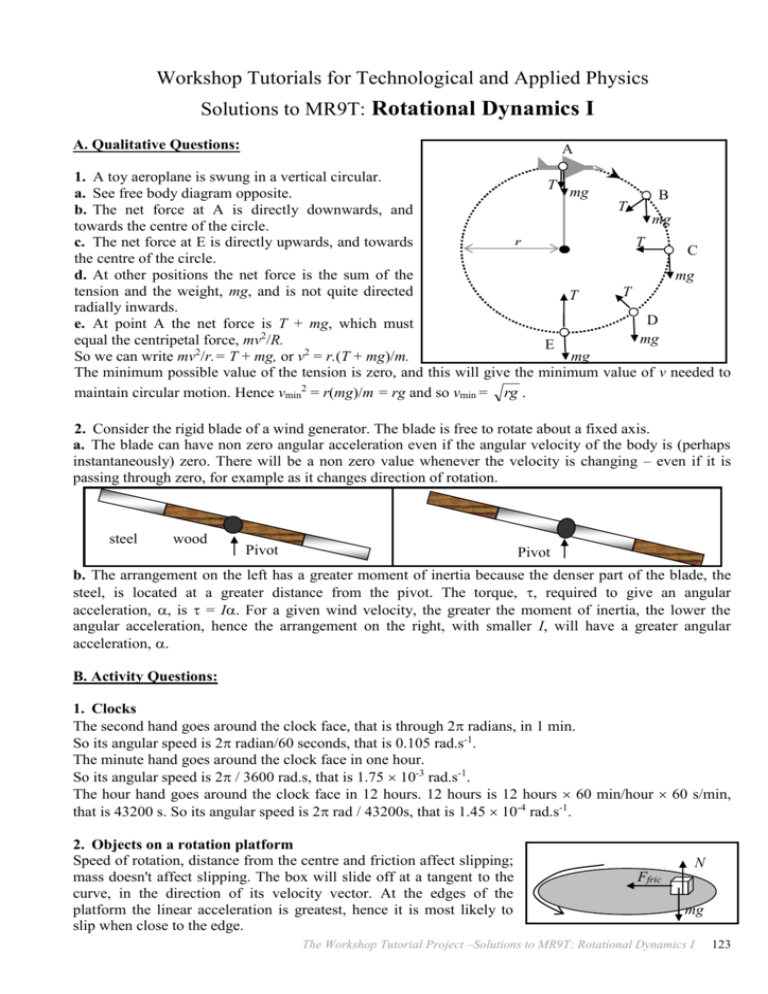
Workshop Tutorials for Technological and Applied Physics Solutions to MR9T: Rotational Dynamics I A. Qualitative Questions: A 1. A toy aeroplane is swung in a vertical circular. T mg a. See free body diagram opposite. B T b. The net force at A is directly downwards, and mg towards the centre of the circle. r T c. The net force at E is directly upwards, and towards C the centre of the circle. d. At other positions the net force is the sum of the mg tension and the weight, mg, and is not quite directed T T radially inwards. D e. At point A the net force is T + mg, which must 2 mg equal the centripetal force, mv /R. E 2 2 So we can write mv /r.= T + mg, or v = r.(T + mg)/m. mg The minimum possible value of the tension is zero, and this will give the minimum value of v needed to maintain circular motion. Hence vmin2 = r(mg)/m = rg and so vmin = rg . 2. Consider the rigid blade of a wind generator. The blade is free to rotate about a fixed axis. a. The blade can have non zero angular acceleration even if the angular velocity of the body is (perhaps instantaneously) zero. There will be a non zero value whenever the velocity is changing – even if it is passing through zero, for example as it changes direction of rotation. steel wood Pivot Pivot b. The arrangement on the left has a greater moment of inertia because the denser part of the blade, the steel, is located at a greater distance from the pivot. The torque, , required to give an angular acceleration, , is = I. For a given wind velocity, the greater the moment of inertia, the lower the angular acceleration, hence the arrangement on the right, with smaller I, will have a greater angular acceleration, . B. Activity Questions: 1. Clocks The second hand goes around the clock face, that is through 2 radians, in 1 min. So its angular speed is 2 radian/60 seconds, that is 0.105 rad.s-1. The minute hand goes around the clock face in one hour. So its angular speed is 2 / 3600 rad.s, that is 1.75 10-3 rad.s-1. The hour hand goes around the clock face in 12 hours. 12 hours is 12 hours 60 min/hour 60 s/min, that is 43200 s. So its angular speed is 2 rad / 43200s, that is 1.45 10-4 rad.s-1. 2. Objects on a rotation platform Speed of rotation, distance from the centre and friction affect slipping; mass doesn't affect slipping. The box will slide off at a tangent to the curve, in the direction of its velocity vector. At the edges of the platform the linear acceleration is greatest, hence it is most likely to slip when close to the edge. N Ffric mg The Workshop Tutorial Project –Solutions to MR9T: Rotational Dynamics I 123 3. A loaded race Neglecting air resistance all the solid spheres will hit the bottom at the same time. From energy conservation equations we have mgh = ½ mv2 + ½ I2. Rearranging for v gives v 10 7 gh for solid spheres. Thus the velocity at the bottom of the ramp is independent of M and R hence all the balls should reach the bottom at the same time. For a solid cylinder v 4 3 gh , so generally spheres have a higher speed than a cylinder. C. Quantitative Questions: 1. One block has a mass of 500 g, and the other a mass of 460 g. The pulley has a radius of 5.00 cm. When released from rest, the heavier block falls 75.0 cm in 5 s (without the cord slipping on the pulley). a. The acceleration, a, of the blocks are of constant magnitude, either up or down. If down is taken to be +ve and '+a' is the acceleration of the heavier block, its vertical displacement is given by y = ½ at2. The pulley accelerates due to the torque from the rope. The torque results from the tensions in either part of the rope being different, if they were the same there would be no net torque. b. Both blocks have the same magnitude of acceleration given by 2y 2 0.75 m ( 5.00s) 2 a -2 Th Tl ml a = t2 = = 0.06 m.s . a mlg mh The heavy block accelerates down, the lighter block accelerates up. mhg c. The net force on the heavier block is mhg – Th = mha. So: Th = mh (g –a) = 0.50 kg (9.8 m.s-2 – 0.06 m.s-2) = 4.9 N. d. For the lighter block mlg – Tl = -mla. So: Tl = ml (g + a) = 0.46 kg (9.8 m.s-2 + 0.06 m.s-2) = 4.5 N e. Since the cord does not slip on the pulley, the tangential acceleration of a point on the run of the pulley must be the same as the acceleration of the blocks, so = a/R = 0.060 m.s-2 / 0.050 m = 1.2 rad.s-2. f. We know the acceleration of the pulley, so we can find the moment of inertia if we know the net torque acting on it. The net torque acting on the pulley is T = (Th - Tl)R = I. So now: I= (Th Tl ) R ( 4.9 N 4.5 N ) 0.05m = 1.2 rad.s -2 = 1.4 × 10-2 kg.m2. 2. = (2.0 rad.s-3)t3, the diameter of the flywheel is 0.36 m. a. 1 = (2.0 rad.s-3)(2.0 s)3 = 16 rad = 920o, and 2 = (2.0 rad.s-3)(5.0 s)3 = 250 rad = 14,000o. b. In this time the flywheel turns through an angular displacement of 2 - 1 = 250 rad – 16 rad = 234 rad. The radius r is half the diameter, or 0.18 m. So the distance, d, is d = r = 0.18 m × 234 rad = 42 m. 2 1 c. The average angular velocity is av = t 2 t1 = 250rad - 16 rad = 78 rad.s-1. 5.0s - 2.0s There are 2 radians per revolutions so av = 2 × 78 rad.s-1 = 12.4 rev.s-1 = 740 rev.min-1. d. The instantaneous angular velocity is given by = d /dt = d/dt [(2.0 rad.s-3) t3] = 2.0 rad.s3 (3t2) = 6.0 rad.s-3t2. So at time t = 3.0 s, = 6.0 rad.s-3t2 = 6.0 rad.s-3× (3.0 s)2 = 54 rad.s-1. e. The acceleration is the change in velocity. The values of at the two times are 1 = 6.0 rad.s-3× (2.0 s)2 = 24 rad.s-1 and 2 = 6.0 rad.s-3× (5.0 s)2 = 150 rad.s-1, 150rad.s -1 - 24 rad.s -1 so the average angular acceleration over this time is av = = 42 rad.s2. 5.0s - 2.0s f. The instantaneous angular acceleration at any time is = d/dt = d/dt [6.0 rad.s-3t2] = 12 rad.s-3 × t. g. So at t = 2s the angular acceleration is = 12 rad.s-3 × t = 12 rad.s-3 × 2.0 s = 24 rad.s-2. Note that the acceleration is not constant but is increasing in time in this case. 124 The Workshop Tutorial Project –Solutions to MR9T: Rotational Dynamics I
